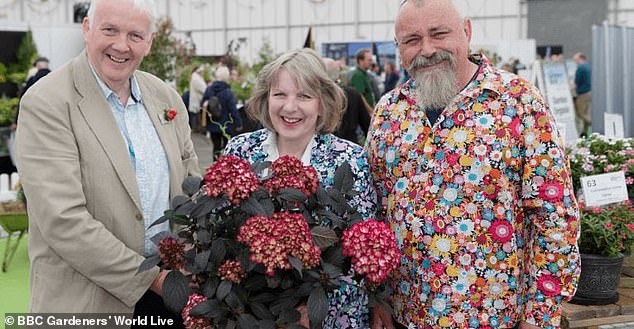The annual BBC Gardeners’ World Live event kicked off this week in Birmingham and tens of thousands of green-fingered attendees were among the first to discover the identity of the Best New Plant 2024.
This year, the prestigious title was awarded to Hydrangea macrophylla First Editions® Eclipse®, earning Allensmore Nurseries of Hereford the coveted Peter Seabrook Award.
The plant attracts attention for its deep purple, disease-resistant, non-fading foliage and its crimson-edged flowers.
The Peter Seabrook Award honors the late British gardening writer and broadcaster, who presented BBC programs including 1975’s Gardeners’ World.
Hydrangea macrophylla First Editions® Eclipse® won Hereford’s Allensmore Nurseries the coveted Peter Seabrook Award at BBC Gardeners’ World Live in Birmingham
The Prize is offered to new plants that were not on sale to the public before June 13, 2024, and to be eligible they must be new varieties, color breaks or characteristics that improve an existing variety.
There are around 80 wild species, many of great garden value, including Hydrangea macrophylla, the most popular.
After centuries of breeding, H. macrophylla varieties come in “mop head” types with large, rounded flower heads as well as lacy caps.
The name is derived from Hydra, the many-headed Greek monster slain by Heracles, not from “hydro.”
The most colorful parts of mopheads are the sterile bracts, each arranged in fours to form flower shapes. The true flowers are tiny and hidden among the bracts. In lacecap varieties, the true flowers form the centers, which are surrounded by an outer ring of bracts.
The new Hydrangeas macrophylla First Editions® Eclipse® has disease-resistant foliage that maintains its deep purple color over a long blooming season.
The flowers are cherry-colored on the edge and a touch of lime green in the center, and the plant is the first truly dark-leafed mophead hydrangea.
Hydrangeas look best in late summer. But they also produce early flowers and, if managed well, the bushes can flower from June to November.
It is recommended to grow them in rich, fertile, moist soil to which compost is added before planting, or in large tubs.
Its buds form at the end of summer and the spent flowers form an important protective layer for them, so it is not advisable to remove them until after the last frosts.
When you prune, trim back to the first pair of healthy buds. Any old, crossed or dead wood should be cut to the base of the bush.

